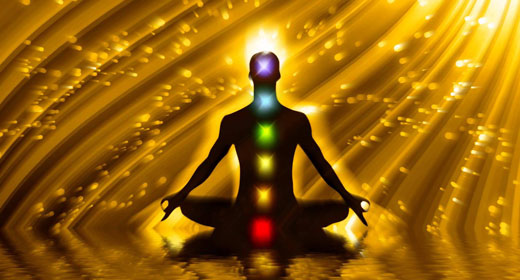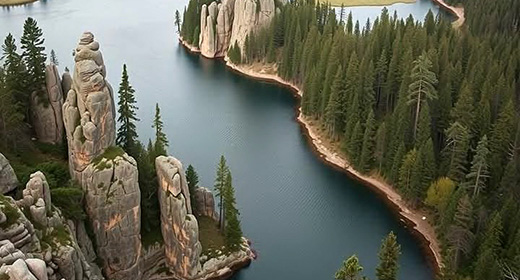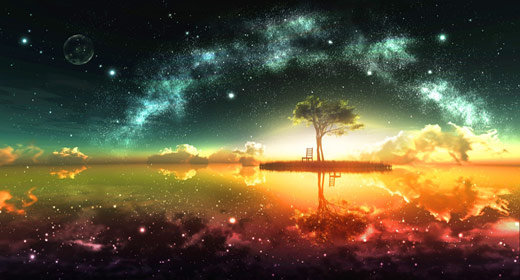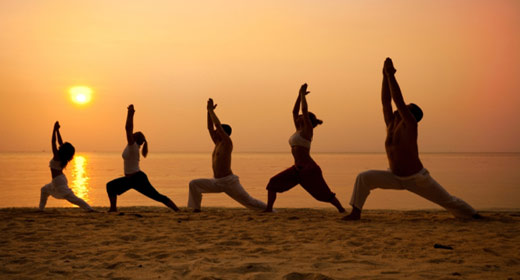by Anodea Judith PhD: Q: What are the chakras?

The word chakra is Sanskrit for wheel or disk, and you can think of the chakras as vortices of energy that exist at the meeting point of mind and body. They function as resistors or capacitors for increasing or diminishing the energies that come into us from the outside, and move out to the world from our insides. In this way they are portals between the inner and outer world.
My particular definition is that they are “centers of organization for the reception, assimilation, and transmission of life force energy.” This life force energy exists on different levels and is represented by the elements of the chakras: earth, water, fire, air, sound, light, and thought.
The chakras describe the architecture of the soul. By opening and balancing our chakras we become more alive, more effective, more present and more awake spiritually.
The chakra system is a profound formula for wholeness and a template for transformation. If we line up our life force energy along the core of the energy body, where the chakras exist, we gain access to all dimensions of human possibility. As we balance and develop these chakras, we become more balanced and healthy in our lives.
Q: Can working with the chakras help get rid of fear?
Yes. Fear is the demon of the first chakra, which relates to grounding, the earth, and the body. When we are fully embodied and grounded, we have ways to combat fear and turn it into an ally of strength. Engaging the legs with the earth gives us something to push into, and energetically grounds the body, which brings stability and more security. In a culture that denies the earth and the body, it is no surprise that we have a lot of rampant fear.
Q: Is there such a thing as a closed or stuck chakra?
Yes, indeed. Chakras exist in the inner world, but they can be protected by defenses that we erect in childhood. However, as adults, these defenses may actually deny the life force energy from moving through freely. Then you could say the chakra is stuck or closed.
Chakras can be stuck in an open position or a closed position. If they are stuck open they become excessive and overblown. If they are stuck closed, they become deficient or restricted. A deficient chakra results from the habit of avoiding something, while an excessive chakra results from trying to compensate for something.
For example, if you didn’t get enough touch or affection in your childhood, you might avoid touch altogether and become cold and distant, or you might become addicted to touch and sensation, trying to compensate for your wound. If the chakras become stuck in these positions, it throws the whole system off and we are no longer balanced in our outlook toward the world. One aspect, such as power or thinking becomes dominant in our behavior, while other aspects, such as love, feeling, or intuition, become absent or underdeveloped.
Q: How do you assess chakra deficiency and imbalance?
We can assess our excess and deficiency by:
1) Knowing the healthy function of each chakra, and understanding its corresponding element
2) Looking at our lives and deciding whether we are too focused upon it, or whether we avoid it and are undeveloped. For instance, are we too focused on security, or do we avoid dealng with the physical world? Do we seek positions of power, or do we avoid taking risks altogether? Do we talk too much, or remain excessively quiet? Do we love too much, or keep our hearts closed and tight?
Q: How do you know which chakra to work on first?
When in doubt, start with first chakra and grounding. If you are going to bring more health and balance to a plant, you start with looking at its roots and the ground it is planted in. Is there enough nourishment, room to grow, and absence of weeds? Do the feet and legs connect the first chakra to ground? Do we draw up strength from the earth to support the other chakras? No plant can grow tall without deep roots. The first chakra starts the whole movement through the chakras by pushing into the ground. The name of the first chakra, Muladhara, means root support.
Q: How do I know I’m on the actual chakra since I can’t see it?
It is more about feeling than seeing, more about experiencing than even understanding. The chakras occur in the energy body, so they are an energetic expression of your soul. You can also see the results of the chakras in your outer life: are your relationships successful? Do you express yourself effectively? Are you in touch with our feelings? Are you assertive without being dominating or submissive?
Q: Are some chakras specifics to emotions or disease, e.g. depression, panic etc.?
All of the chakras manage energy and disperse it through the body and into the world. While the second chakra is more associated with emotions, any of the chakras can produce emotional feelings. Depression is when the energy is literally depressed, or held down and prevented from expression and release. Panic is when the third chakra power center has more energy than it knows how to handle. If we have conflicting impulses or beliefs, the third chakra gets confused and can’t disperse the energy, and panic results.
Q: What is the role of colors?
The colors represent the vibratory frequency of the chakra’s energy. It doesn’t mean that chakra IS that color, only that it is associated with that color. The colors serve as a way to visualize the chakras in your meditation.
Q: How can I integrate chakra work with other approaches such as reiki, magnetism or meditation?
Chakras are a structure in the energy body, the way bones are a structure in the physical body. They can be integrated into any healing system or set of spiritual beliefs. They relate to our health, our psychology, our relationships, our illnesses. We can meditate on them, chant their seed sounds, visualize their colors, their deities, or take them as challenges in our lives. Ultimately, we must take it into our lives or it is just spiritual narcissism.
The planet is ailing, and the sacred elements associated with the chakras — earth, water, fire, air, sound, light, and thought — are all threatened in some way. By aligning our chakras within, we align better with the outer world and thereby begin to make a connection through which we can bring healing, not only to ourselves, but to others and the world around us.
Ultimately the chakra system is a map for our personal journey, but also the journey we take as a civilization through the process of evolution. Currently we are coming to the end of the third chakra era, related to power and aggression, and moving into the heart, which is related to peace and community. We are moving from the love of power to the power of love. By raising our own consciousness, we become part of this global shift. The chakras are the structure upon which to navigate our development.
Q: Is there a basic meditation technique you use to align the chakras?
Imagine the chakras are brightly colored jewels, strung along the center line that runs in front of your vertebrae, between crown and base. When that center line is stretch out straight, the chakras move toward alignment.
Sitting in meditation, imagine roots coming out the base of your spine, anchoring you into the earth below, sending them as far below as you can imagine, even to the center of the earth.
While keeping your roots pulling downward, simultaneously lift your crown upward, toward the heavens, pulling the two ends of your spine in opposite directions.









































